Share this
A hush fell over the room at Christie’s in New York as bidding reached a fever pitch. The object of desire? René Magritte‘s iconic painting, “L’empire des Lumières” (The Empire of Lights). After a tense back-and-forth, the hammer fell, sealing the fate of this beloved artwork. The final price: a staggering $121.2 million, shattering the previous record for a Magritte by a significant margin.
This wasn’t just a sale; it was a coronation. “L’empire des Lumières” is more than just a canvas adorned with paint. It’s a portal into Magritte’s surreal world, a dreamscape where day and night coexist in an impossible harmony. The painting’s enduring popularity is a testament to Magritte’s genius, his ability to challenge our perceptions and ignite our imaginations.

The record-breaking sale is also a sign of the enduring strength of the art market. Despite global economic uncertainties, high-quality works by masters like Magritte continue to fetch eye-watering sums. This suggests that art remains a coveted asset, a store of value that transcends the vagaries of the stock market.
But beyond the financial frenzy, there’s a human story at play. The sale of “L’empire des Lumières” marks the end of an era for the Mica Ertegun collection, from which it originated. Yet, it also signifies a new beginning for the painting, a chance to inspire and enthrall a new generation of art lovers.
In conclusion, the record-breaking sale of “L’empire des Lumières” is a confluence of artistic merit, market forces, and personal legacies. It’s a reminder that great art transcends time and circumstance, a beacon of beauty and wonder in an ever-changing world.
